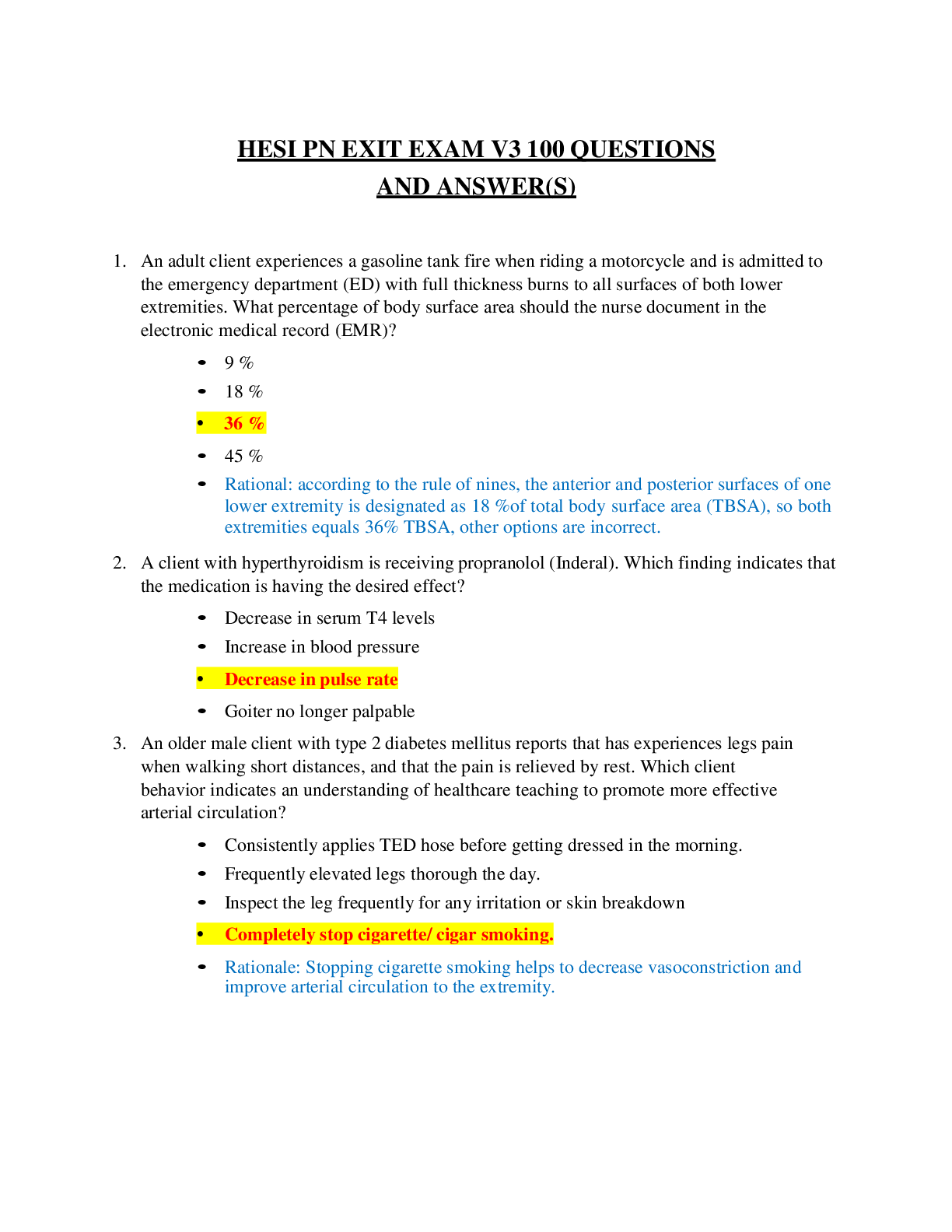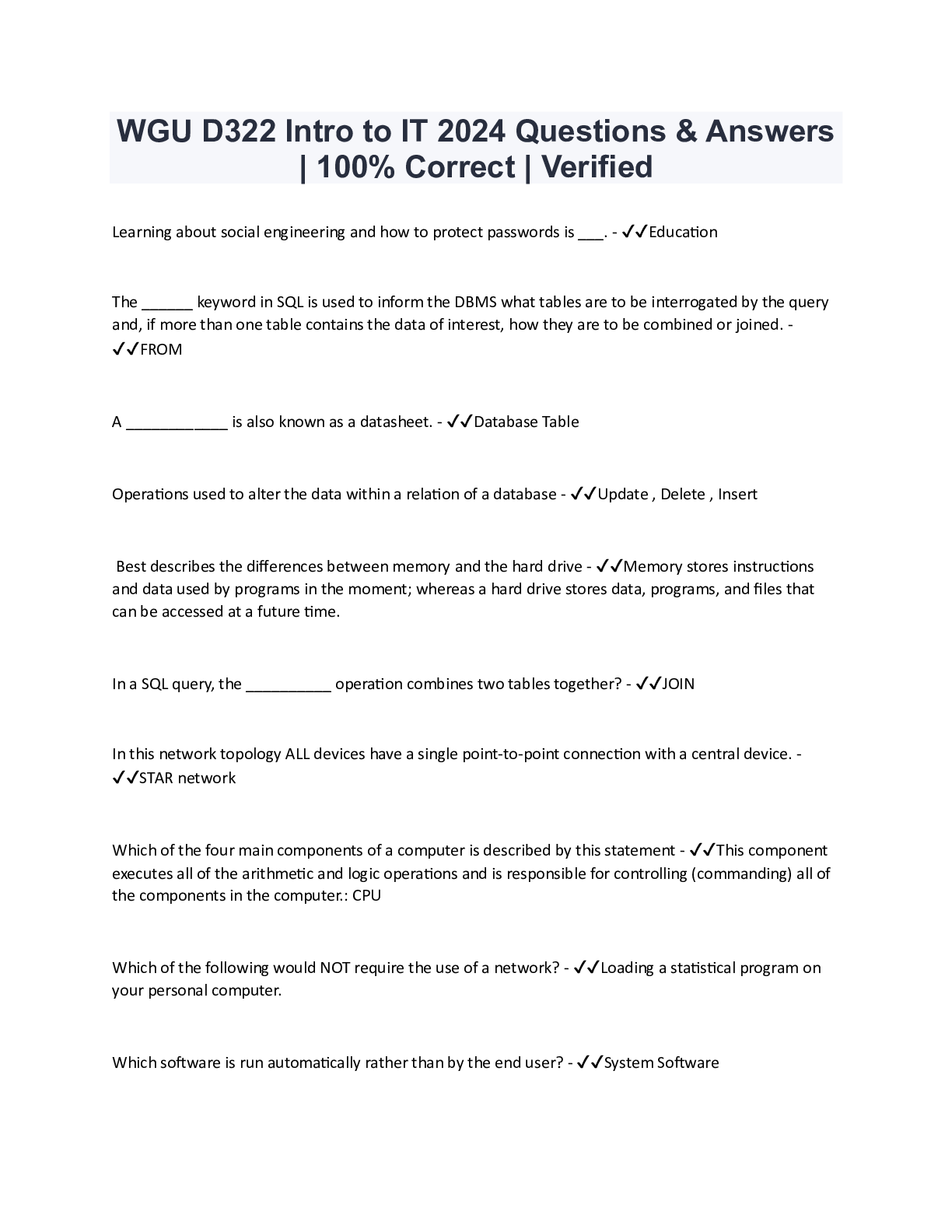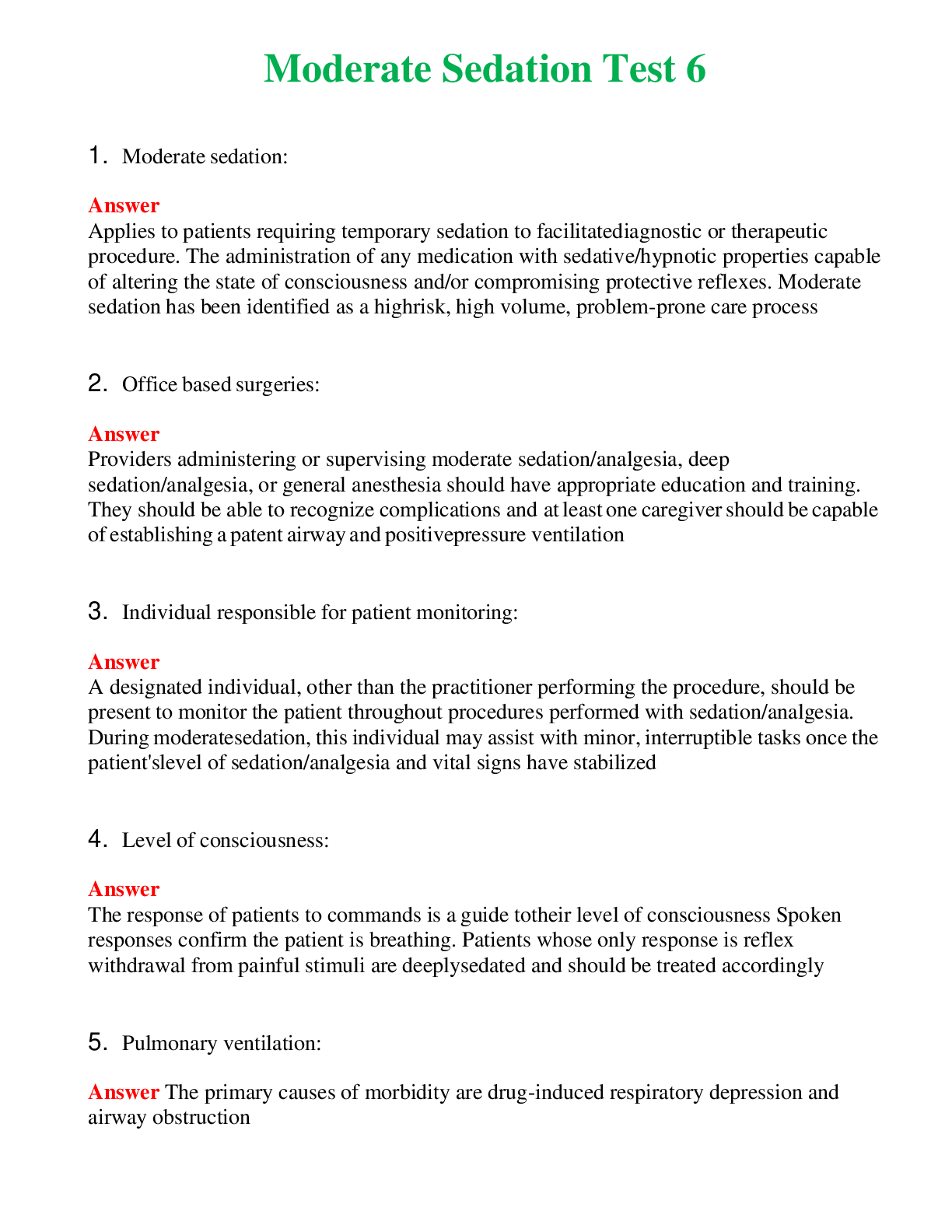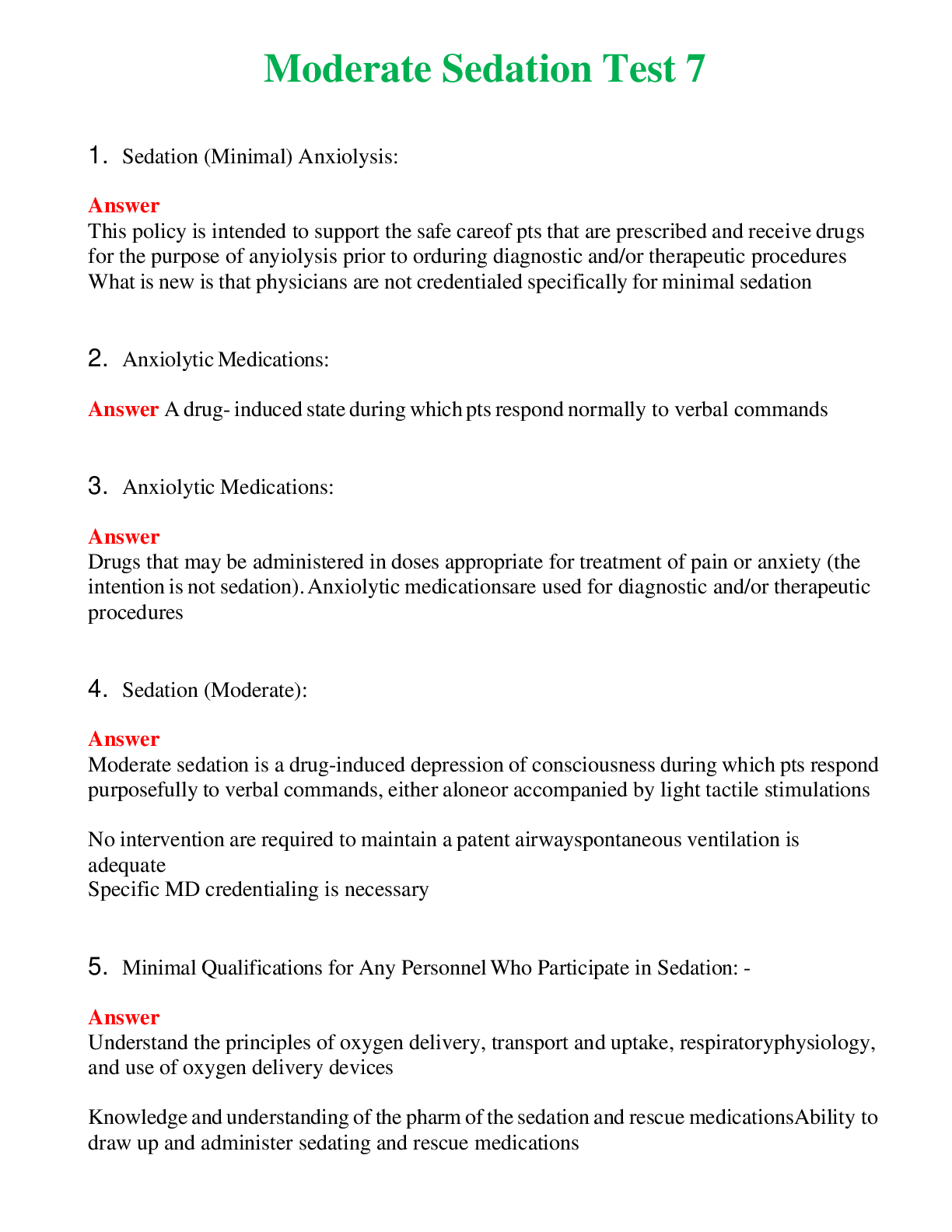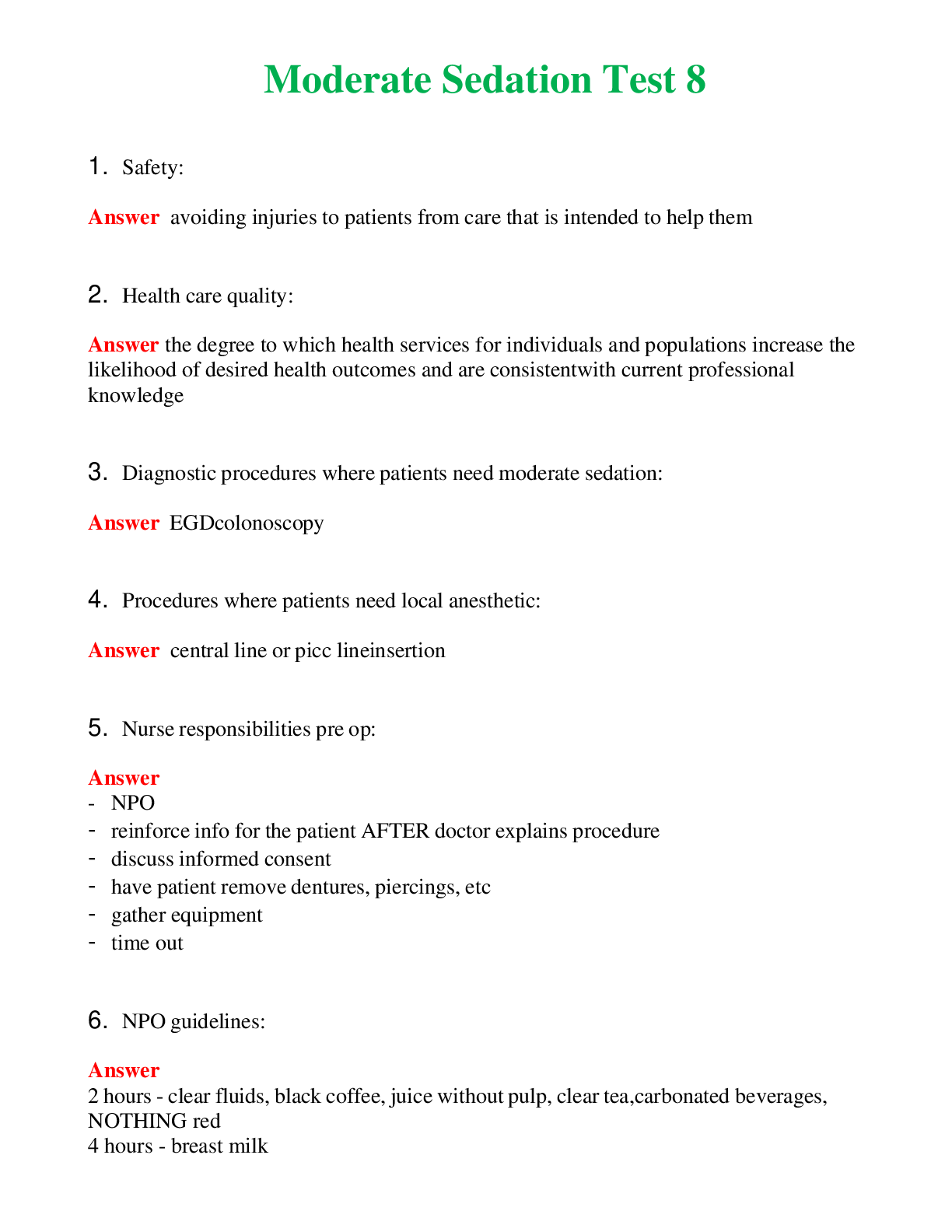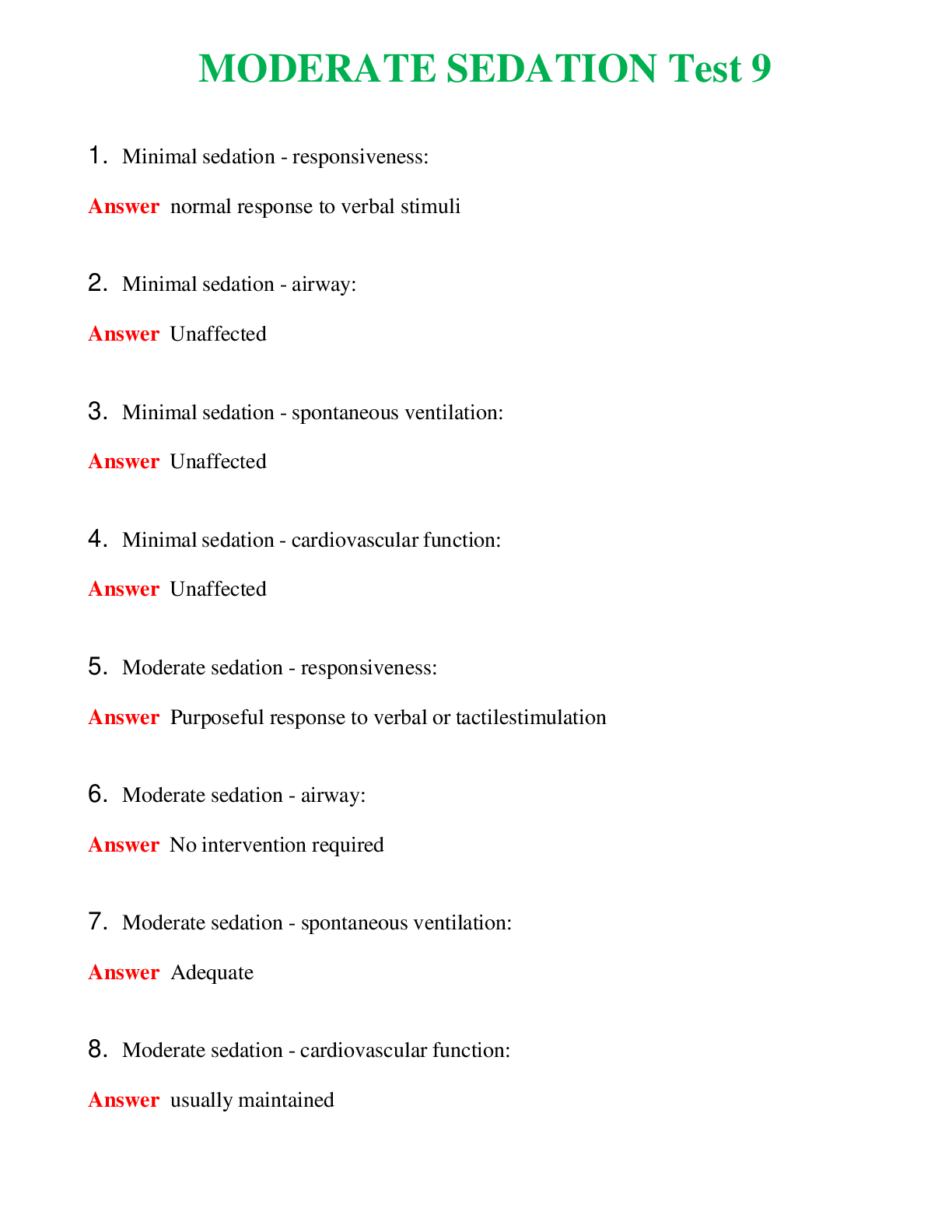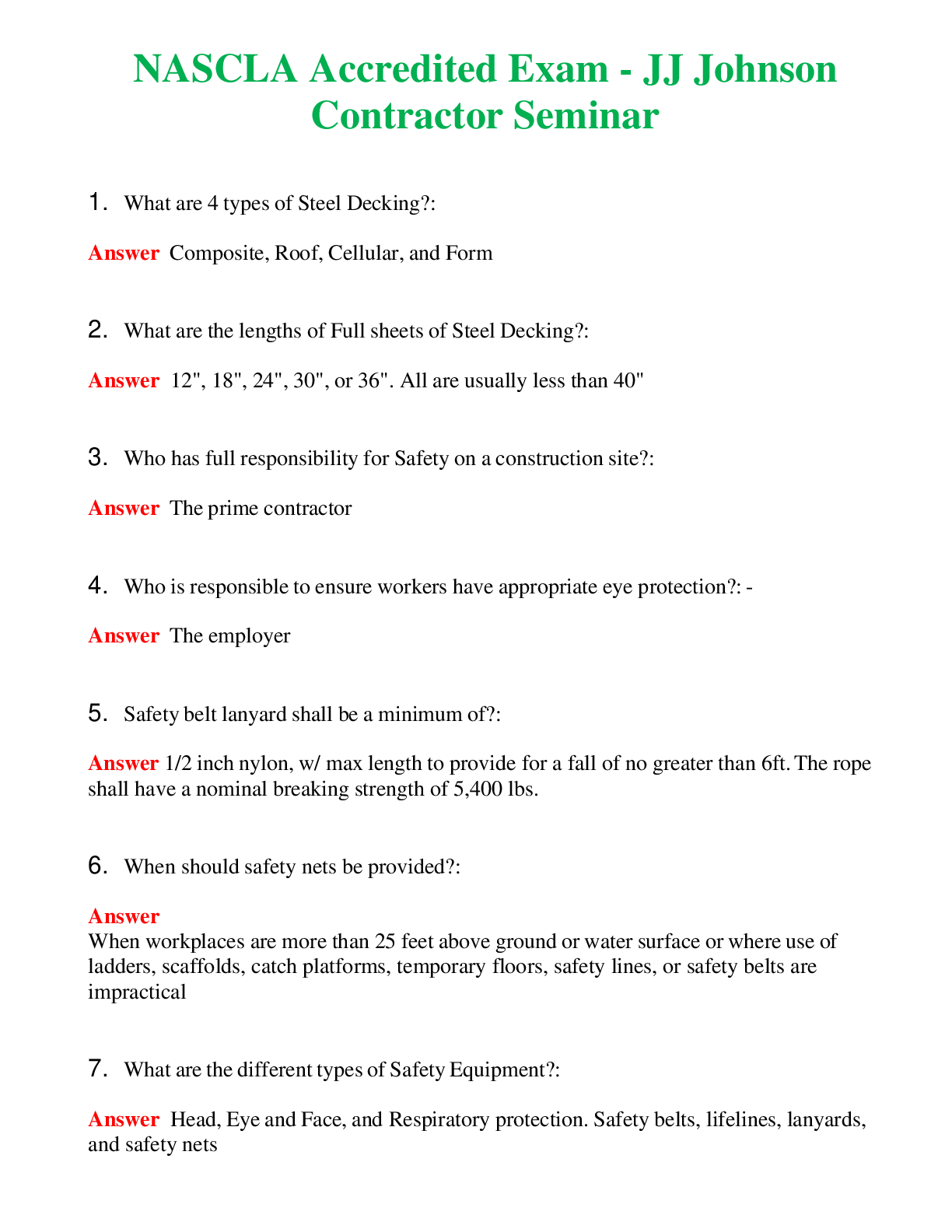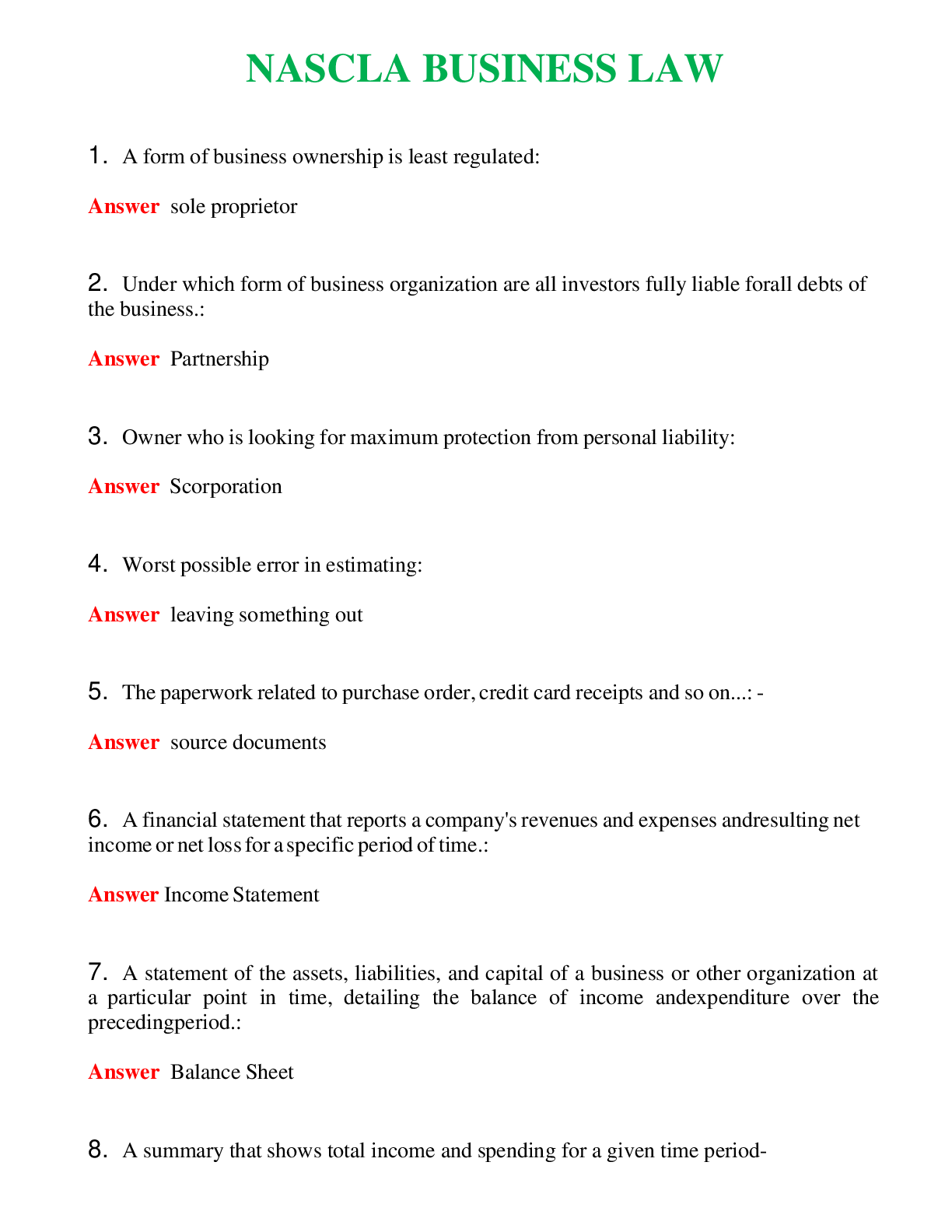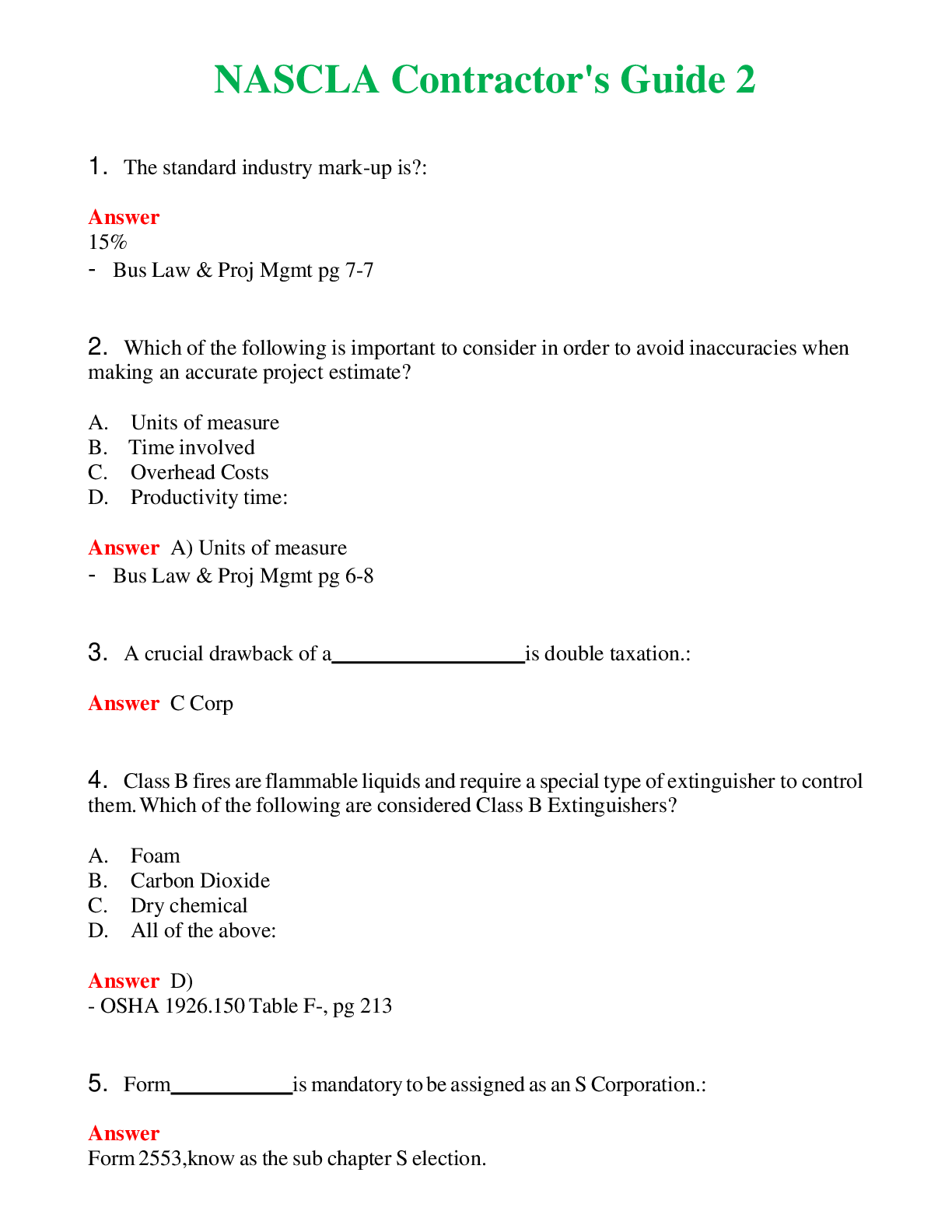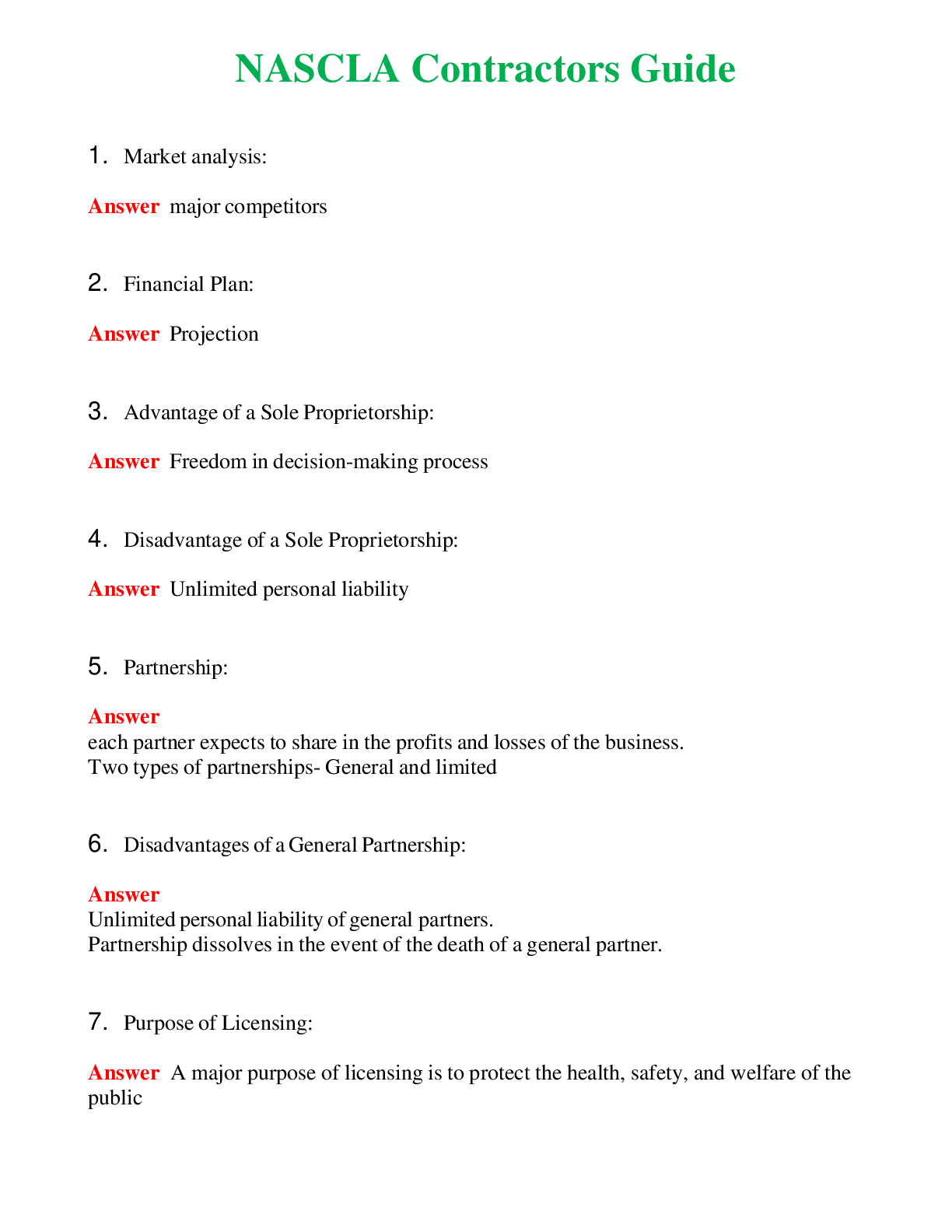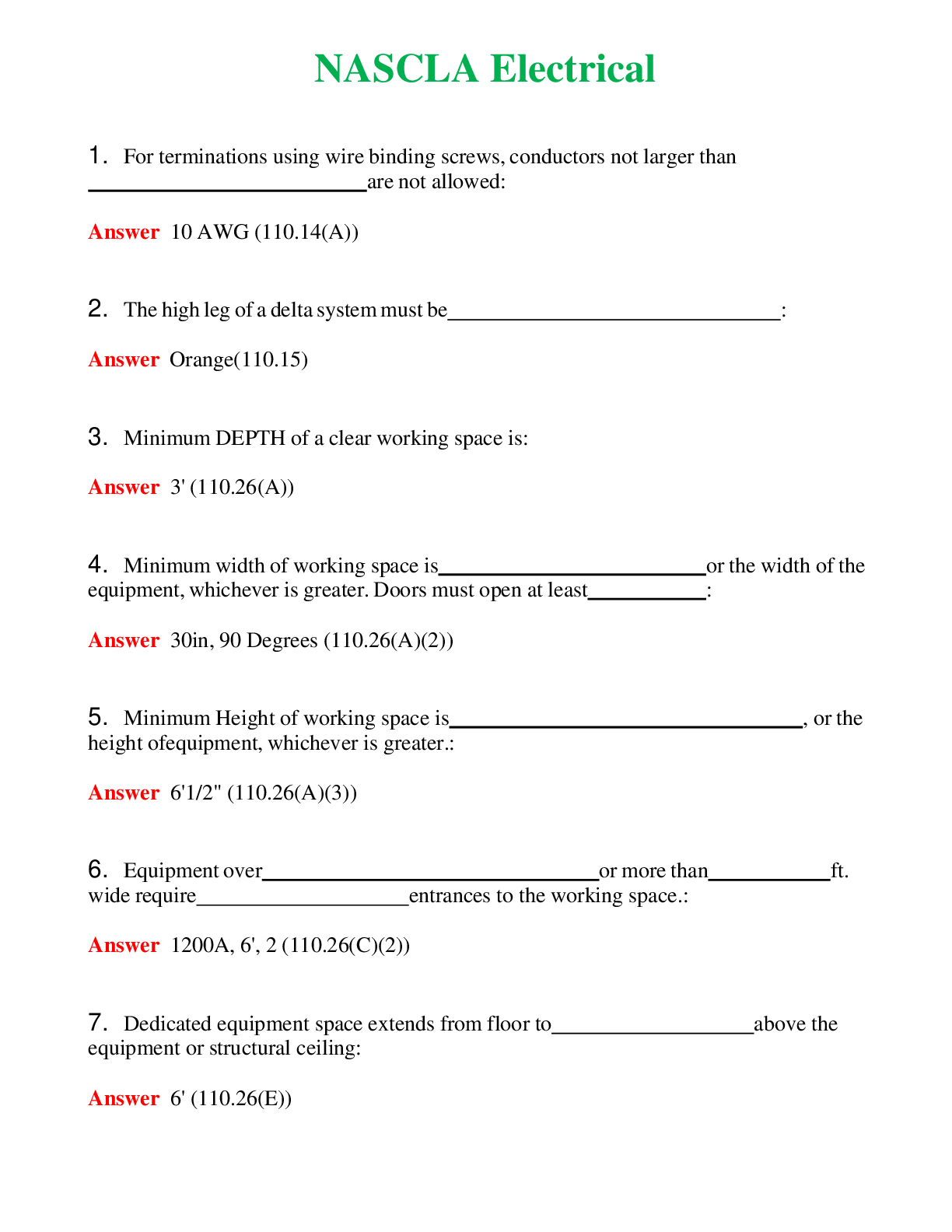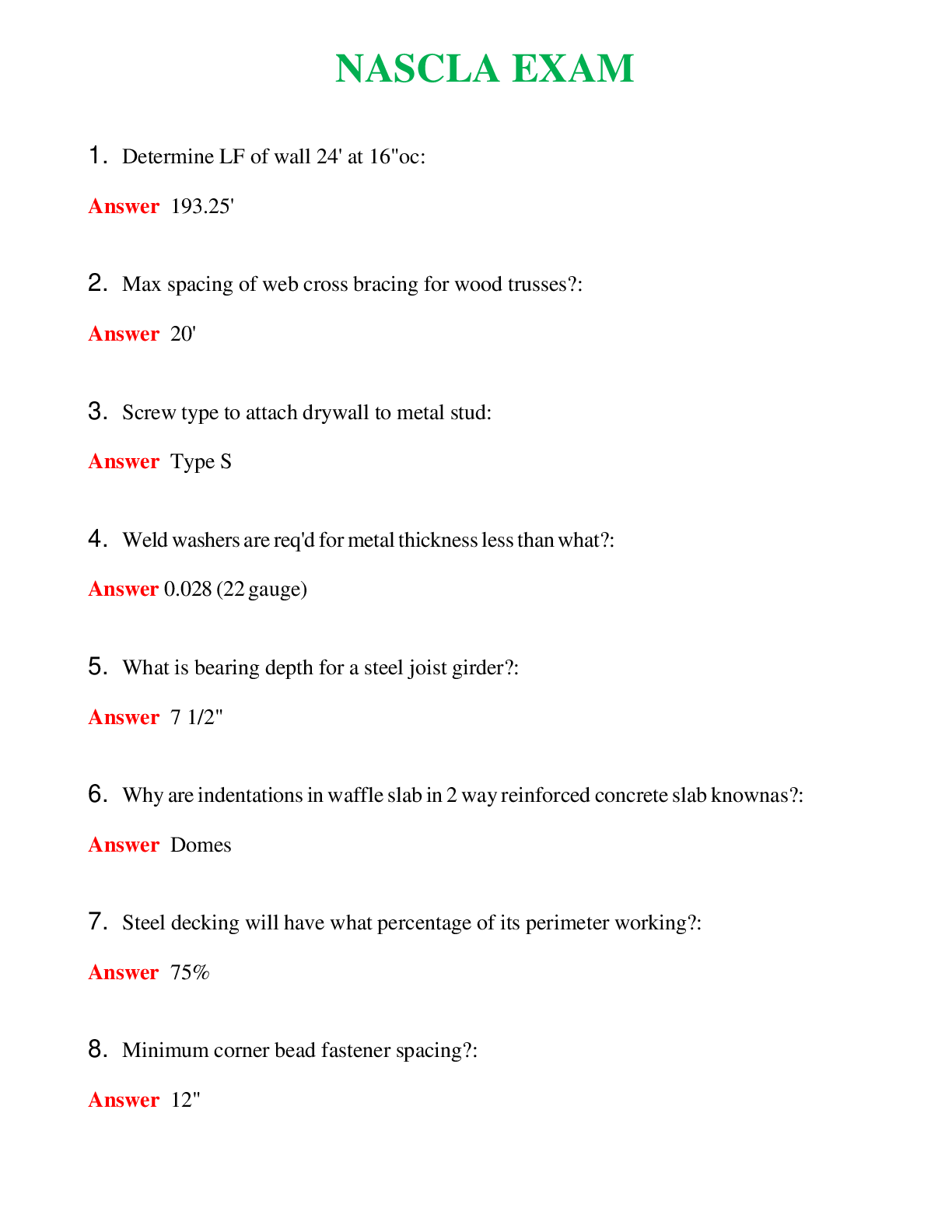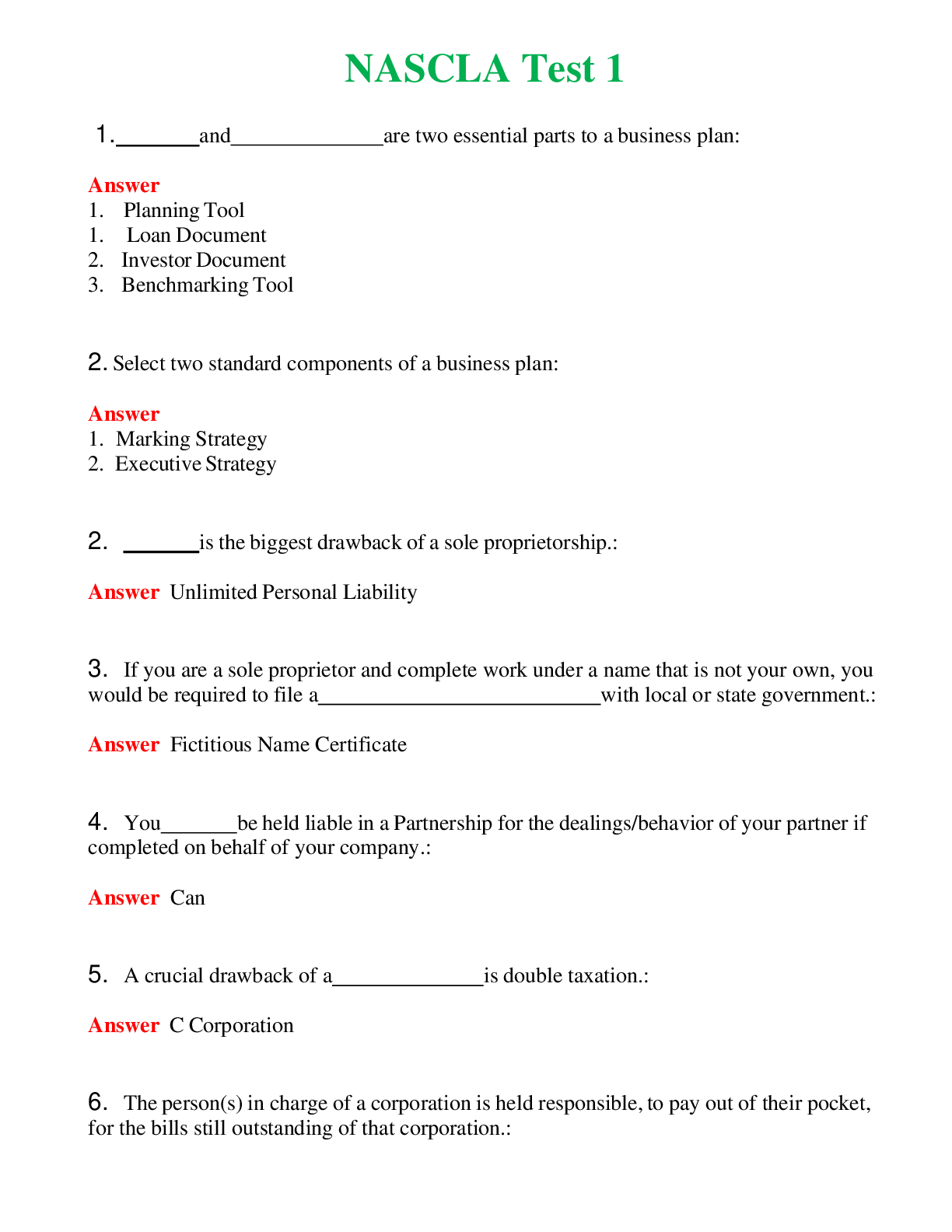Human Resource Management > EXAM > BUSN 3350 MIDTERM EXAM 2 (Latest version, 2022 -All Answers are Correct) (All)
BUSN 3350 MIDTERM EXAM 2 (Latest version, 2022 -All Answers are Correct)
Document Content and Description Below
Chapter 7 Selection For the position of a police officer, which of the following is a “must criteria”? 1. Have a positive reputation. 2. Leadership skills. 3. Completion of postsecondary e ... ducation. Must criteria are absolutely essential for the job, include a measurable standard of acceptability or are absolute. There are often only two musts: a specific level of education (or equivalent combination of education and work experience) and a minimum amount of prior work experience. Therefore, completion of postsecondary education can be a must criteria. 4. Have the ability to work independently. Which of the following examples demonstrates a legally indefensible selection process? 1. Secure written authorization for reference checking from prospective employees. 2. Ask questions about compensation history and childcare arrangements indirectly. In order to determine possible accommodations. This is illegal given that Canadians are protected from direct and indirect discrimination in employment related decisions, as stated in Chapter 2. 3. Keep records about the applicant during each stage of the selection process. 4. Reject applicants who make false statements on their application forms or résumés. What is the selection ratio? 1. Number of Applicants Interviewed ÷ Number of Applicants Hired 2. Total Number of Applicants ÷ Number of Applicants Hired 3. Number of Applicants Interviewed ÷ Total Number of Applicants 4. Number of Applicants Hired ÷ Total Number of Applicants According to research, which of the following test is the strongest predictor of job success? 1. Personality test. 2. Aptitude test. 3. General Mental Abilitiy test. Empirical research suggests that general mental ability is the strongest general predictor of job performance at one’s chosen occupation. 4. Interest inventories. Which of the following is true about personality test? 1. Research studies confirm that personality tests do not help companies hire more effective workers. 2. Personality tests can be used in career planning, since people generally do better in jobs involving activities in which they have an interest. 3. Faking is a serious threat to the validity of personality inventory in the assessment process. Evidence supports two specific trends in personality tests and faking: (1) people can fake personality inventories when they are motivated to do so, and (2) individual differences exist in the ability to fake. 4. The Minnesota Multiphasic Personality Inventory (MMPI) is believed to be the most widely used personality inventory in the world. What is differential validity? 1. The extent that a selection instrument, such as a test, adequately samples the knowledge and skills needed to perform the job. 2. The degree that selection procedures yield comparable data over time. 3. The extent that a selection tool predicts or significantly correlates with important elements of work behaviour. 4. Confirmation that a selection tool accurately predicts the performance of all possible employee subgroups. In which evaluation technique are candidates presented with hypothetical circumstances representative of the job for which they are applying (often on video) and evaluated on their responses? 1. Work sampling. 2. Micro-assessments. 3. Interest inventories. 4. Situational testing. Which of the following is not a common interviewing mistake? 1. Similar-to-me bias and leading 2. Poor planning and snap judgments 3. Negative emphasis and halo effect 4. Using situational and behavioural questions Which of the following is the major benefit of a semi-structured interview compared to a structured interview? 1. The same questions can be used for a variety of jobs. 2. It relies less on knowledge of the job. 3. The interview is more conversational. A semi structured interview is more conversational than a structured interview, given that interviewers are allowed to ask follow-up questions. 4. It is quicker to conduct than the structured interview. Mildred has decided to check on the social networking sites of job applicants to get a better awareness of who the applicants are. Which of the following is true? 1. Mildred can do this as social networking is public. Given the social networking site information is uploaded in a public space by the employees, written permission from job applicants is not required. The applicants can make their sites private or limit access, but if the applicant provides access, then the information is deemed to be available. 2. Mildred cannot do this without the written permission of job applicants. 3. Mildred cannot do this as it violates human rights legislation. 4. Mildred can and should do this as it is within the spirit of human rights legislation. Which of the following is not an appropriate question for a reference check, either written or verbal? 1. Previous job title. 2. Information pertaining to lifestyle and personal relationships. 3. Dates of employment. 4. Verifying the role of the individual in the company. When you provide a reference for a former employee and your comments are made in confidence for a public purpose, without malice, and are honestly believed, you: 1. refrain from imparting any negative information. 2. should direct the request to other potential references. 3. should adopt a “no reference” policy. 4. can rely on the defense of qualified privilege. This is the definition of the qualified privilege defense. When a job candidate is asked to perform key tasks associated with the job that they are applying to, this is known as: 1. Grade-point average 2. A personality test 3. Interest inventories 4. Work sampling Work samples focus on measuring job performance directly through completion of poor work tasks, which are monitored and measured by the test administrator. Although the HR department staff members generally play a major role in compiling all the selection data, usually the immediate supervisor is responsible for making the final hiring decision. 1. False 2. True Who commonly makes the final hiring or selection decision? 1. The HR recruitment specialist 2. The immediate supervisor 3. The HR manager 4. The director or VP of the department Research has shown that this strategy is best for building a reliable and valid selection decision. 1. Using gut feel (subjective) alone. 2. Using statistical strategy (objective) alone. Objective criteria should be used to establish reliable and valid. 3. Mixing gut feel (subjective) with statistical results (objective) decisions equally. 4. Using statistical strategy (objective) to defend decisions that were made on gut feeling (subjective). Jennifer is frustrated. An important position opening that she advertised has received only four responses and only one person meets the minimum qualifications and only marginally. What is likely the most appropriate course of action for Jennifer? 1. Repost or re-advertise the job perhaps through different media 2. Change the job requirements 3. Hire the best candidate of the four who applied 4. Leave the position open and try again in six months Confirmation that the selection tool accurately predicts the performance of all possible employee subgroups, including white males, women, visible minorities, persons with disabilities, and Indigenous people is called: 1. differential validity. Differential validity ensures that the tool accurately predicts performance of all possible employee subgroups. 2. construct validity. 3. content validity. 4. criterion-related validity. Bob, Stella, and Amir interviewed two candidates for a position with their organization, Tradco Industries, but at the end of the interviews, Bob, Stella, and Amir had reached vastly different conclusions regarding the candidates. What would be true in this situation? 1. The interview is definitely valid, but not reliable. 2. This interview is not a reliable measure, but might be valid. The results are not reliable, given that there is no consistency amongst raters. There is no clarity regarding if the interview was valid. Validity is associated with how accurately a predictor measures what it intended to measure. 3. Bob, Stella, and Amir likely do not know how to interview, as interviews are generally very valid. 4. This interview is a reliable and valid measure. You are responsible for screening applicants for several vacancies in your company’s sales department. In addition to the usual selection criteria, the hiring manager has asked you to identify outgoing, people-person candidates. Which screening tool would be most appropriate? 1. The Crawford Small Parts Dexterity Test. 2. The Stanford-Binet Test. 3. The Myers-Briggs Type Indicator. This is a test to identify personality. The selection criteria is seeking people with the specific personality, therefore, this test would be the most appropriate screening tool. 4. The General Aptitude Test Battery. A strategy used to provide applicants with information—both positive and negative—about the job demands, the organization’s expectations, and the work environment is known as a: 1. selection criteria. 2. NOC match. 3. realistic job preview. A realistic job preview provides potential employees with a chance to work the actual job, thereby providing them with the desired information in the question. 4. reference check. In an interview for a customer service position with a cellular phone company, Mike was asked a series of questions such as “Tell me about a time when you had a conflict with a co-worker. What happened and how was it resolved?” What type of interview question is Mike experiencing? 1. Hypothetical. 2. Situational. 3. Behavioural. 4. Assumptive. Applicants for the job of air traffic controller must be able to visualize objects moving in three dimensions and write a test to determine if they have this ability. What category would this test fall into? 1. Emotional intelligence test 2. Interest inventory 3. Personality test 4. Aptitude test Which of the following is not appropriate on an application form? 1. Asking the applicant to disclose any prior arrests 2. Asking the applicant to provide the name of the high school, college or university attended 3. Asking the applicant to provide names, addresses, and phone numbers of references 4. 1. And 2. Only 5. 1. And 3. only Which of the following would not be considered an example of a biographical information blank (BIB) question: 1. At what age did you leave home? 2. How large was the town in which you grew up? 3. Do you play any musical instruments? 4. Are you legally permitted to work in Canada? 5. Only 3 and 4 are not examples Which type of test measures dispositional characteristics such as extroversion, inquisitiveness, and dependability? 1. Personality tests 2. Cognitive ability tests 3. Physical ability tests 4. Supervisory and managerial ability tests 5. Achievement tests The type of interview that allows the maximum amount of freedom in determining the course of discussion is the: 1. Unstructured interview 2. Depth interview 3. Situational interview 4. Structured interview 5. Behaviour interview Chapter 8 Onboarding and Training What is the main difference between onboarding and training? 1. Onboarding is continuous, training lasts only for a limited time. 2. Training has to do with learning about things, onboarding has to do with learning about people. 3. Onboarding is learning about the specific job, training is filling in employment forms. 4. Training addresses doing the job, onboarding addresses working in the organization. Which of the following would not typically be included in an onboarding program? 1. An interview to determine “fit” in the organization. 2. A tour of the company’s facilities. 3. A review of duties and responsibilities. 4. An overview of performance appraisal. A well-developed employee orientation (onboarding) program has a number of advantages such as fewer instances of corrective discipline, fewer employee grievances, and: 1. decreased socialization. 2. increased turnover. 3. reduced number of workplace injuries. 4. decreased morale. Which of the following phrases best describe socialization? 1. An opportunity to get to know colleagues. 2. A process aimed at giving the new employee a better idea of the organization’s competitive position. 3. A process to learn how to use common equipment in the workplace. 4. A process of instilling attitudes, values, and patterns of behaviour in the new employee. How long can full executive integration take? 1. 12 months 2. 18 months 3. 24 months 4. 6 months What is negligent training? 1. Occurs when an employer fails to train adequately, and an employee subsequently harms a third party. 2. Occurs when an employer fails to provide occupational health and safety considerations during training activities. 3. Occurs when an employer fails to provide employee with onboarding checkpoints, and subsequently causes the employee to fall behind in training. 4. Occurs when an employer fails to check references upon hiring and the employee subsequently harms the reputation of the company. A number of actions can be taken before, during, and after a training program to enhance transfer of training. Which of the following is not a recommended action to take? 1. Potential trainees can be assessed on their level of ability, aptitude, and motivation regarding the skill to be taught. 2. Trainees needs impactdesigning the training. 3. Provide frequent feedback, opportunities for practice, and positive reinforcement. 4. Evaluation of the program to see how well its objectives have been met is not necessary. Evaluation of the program objectives is a necessary component to ensure training is affected. There are five steps to the training and development process. Which step identifies specific job performance skills to improve performance and productivity? 1. Instructional design. 2. Needs analysis. The first step is needs analysis which identifies job performance skills that need further training. 3. Evaluation. 4. Implementation. What is the difference between task analysis and performance analysis? 1. Task analysis looks at the job, performance analysis looks at the person doing the job. 2. Performance analysis deals with the job, task analysis deals with the person doing the job. 3. Performance analysis must be done before task analysis. 4. Task and performance are the same thing. What is a controlled experiment? 1. Uses both a training group and a control group (that receives no training) to isolate and assess the impact of the training. 2. Evaluates the impact of training on both the trainers and trainees. 3. Controls for changes in personal perspective by collecting data on trainees before and after the training. 4. Stops any other forms of organizational change during training to isolate and assess the impact of the training. Which of the following statements is false? 1. The third step in the training process is validation, in which the bugs are worked out of the training program by presenting it to a small, representative audience. 2. In the second step of the training process, instructional design, the actual content of the training program is compiled and produced, including workbooks, exercises, and activities. 3. The purpose of the needs analysis step, step four, is to identify the specific job performance skills needed, to analyze the skills and needs of the prospective trainees, and to develop specific, measurable knowledge and performance objectives. 4. In the fifth step of the training process, there should be an evaluation and follow-up step in which the program’s successes or failures are assessed. Cultural sensitivity training is best described by which of the following phrases? 1. It is a process to develop outstanding customer service. 2. It enhances people’s senses in order to help people with a disability. 3. It is a process to develop literacy. 4. It develops understanding of views of different groups. Cultural sensitivity broadly develops an understanding of different groups and their perspective or experiences. Which of the following has not been identified as a critical competence required to succeed in the global economy? 1. Business literacy. 2. Social literacy. 3. Cultural literacy. 4. Financial literacy. Which of the following is true about onboarding and training? 1. Training often occurs before the onboarding process. 2. Onboarding is a short-term process, while training is a long-term process. 3. Onboarding focused on organization-specific topics, training focuses on the required skills or knowledge to perform the job at adequate levels. 4. The terms onboarding and training represent the same variation of employee efforts. All of the following represents problems associated with onboarding programs, except which one? 1. Too much information is provided in a short time. 2. Little or no onboarding is provided. 3. Information provided by the immediate supervisor may be too detailed to realistically be remembered. 4. The employee is not interested in the content of the onboarding process. There are a number of advantages to using online onboarding systems such as engaging new hires in a personalized way and accelerating their time-to-productivity by completing benefits decisions, payroll forms, new-hire data, introduction of policies and procedures, and: 1. introducing employees to government regulations. 2. building the employer brand as an employer of choice. 3. showing employees where to bank. 4. connecting employees to union stewards for future grievances. Which of the following is true 1. Usually the immediate supervisor orients the new employee to the company policies and procedures, while the HR department orients the employee to the specific job. 2. Usually the immediate supervisors orients the new employee to the company policies and procedures, and to the specific job. 3. Usually the HR department orients the new employee to the company policies and procedures, and to the specific job. 4. Usually the HR department orients the new employee to the company policies and procedures, while immediate supervisor orients the employee to the specific job. In evaluating the effectiveness of a training program, which of the following is not an outcome measured? 1. Behavior 2. Participation 3. Reaction 4. Learning Which of the following is a reason why training is needed for first-time supervisors and managers? 1. Managers are now much younger than they were 10 years ago. 2. The new manager will have to operate in a global environment. 3. People are promoted for technical competence, but succeed in management based on people skills. As per the text, new supervisors or managers are often chosen for their technical ability, and their interpersonal, or communication skills get overlooked. 4. The literacy skills of employees may be very low. Juan had recently attended a training session. He found that he could not understand the training manual and the classroom session was not relevant to him. In talking with other participants, he found that all of them had the same opinion. What could the trainer have done to have avoided this situation? 1. The trainer should have asked the trainees what they wanted to learn 2. The trainer should have done better task analysis 3. The trainer should have used online training 4. The trainer should have validated the training program Sam enjoyed her recent training program and she thoroughly understands all of the material that she learned. Yet, in the workplace, her actions are exactly the same as before she attended the training. What category of training outcome would correctly assess Sam’s situation? 1. Learning 2. Reaction 3. Behaviour 4. Results Distinguishing between the employee’s ability to do a task and his willingness to do a task is part of what element of the training process? 1. Evaluation 2. Performance analysis 3. Employee analysis 4. Task analysis There are five steps to the training and development process. In which step is the actual content of the training program compiled and produced? 1. Needs analysis 2. Evaluation 3. Validation 4. Instructional design Chapter 10 Performance Management Which elements of performance appraisals are used most by Canadian organizations? 1. Organizational objectives and goals. 2. Behaviours. 3. Values. 4. Individual objectives and goals. In dynamic organizations, when should performance reviews be conducted? 1. Biannually. 2. Annually. 3. Monthly or quarterly. 4. Semi-annually. What is the difference between performance management and performance appraisal? 1. Performance management is the same as performance appraisal. 2. Performance appraisal ievaluates and measures actual performance; performance management is focused on controlling behavior. 3. Performance management is part of performance appraisal. 4. Performance management is the complete process involving all elements relating to improving employee performance; performance appraisals reflect the process of evaluating an employee’s performance. Which one of these processes would not abide by Thorndike’s suggested criteria for employment decisions? 1. The criteria focuses on ideal expectations, rather than practical ones. Robert Thorndike researched performance management processes and suggests that employment decisions (such as a performance appraisal system) must be valid, practical, reliable, and free from bias. 2. The criteria reflects an element of the job related to performance. 3. The criteria can be consistently applied to all employees in the job. 4. The criteria is free from direct and indirect bias. Which of the following is a poorly designed performance improvement plan? 1. Highlights in writing the expectations of the employer and employee. 2. Provides a flexibility regarding the employee identifying at a future date the when they think they can bring performance to acceptable levels. 3. It lists objectives that are considered to be reasonable. 4. Identifies a date of follow-up and the names of parties who engaged in the conversation. All of the following are reasons to appraise performance, except… 1. Developing plans for employee development. 2. Informing compensation decisions. 3. Making retention decisions during downsizing. 4. Discussing career opportunities. Which performance appraisal method requires identifying a pre-set percent of employees as strong performers? 1. Paired comparison method. 2. Alternation ranking method. 3. Forced distribution method. 4. Graphic rating scale. Which one of the following is untrue of the behaviourally anchored rating system? 1. It is a more accurate measure. 2. It assesses dimensions as interdependent. 3. It has clearer standards. 4. It provides useful feedback. A performance rating scale that results in most people being identified as above average or superior performers might be suffering from what problem? 1. Similar-to-me bias. 2. Recency effect. 3. Leniency error. 4. Strictness effect. An employee who demonstrates strong work ethic is given an inflated rating on reliability. This demonstrates which rater error? 1. Unclear performance standards. 2. Central tendency error. 3. Halo effect. In performance appraisa [Show More]
Last updated: 3 years ago
Preview 1 out of 24 pages

Buy this document to get the full access instantly
Instant Download Access after purchase
Buy NowInstant download
We Accept:

Reviews( 0 )
$12.00
Can't find what you want? Try our AI powered Search
Document information
Connected school, study & course
About the document
Uploaded On
May 05, 2022
Number of pages
24
Written in
All
Additional information
This document has been written for:
Uploaded
May 05, 2022
Downloads
0
Views
317

